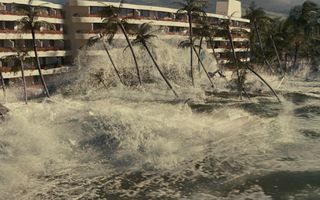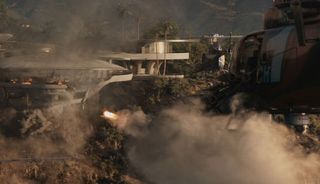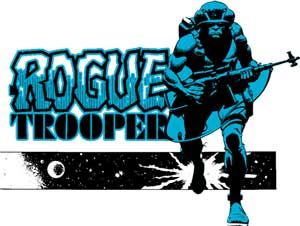This article is brought to you in association with Masters of CG, a new competition that offers the chance to work with one of 2000AD's most iconic characters. There are big prizes to be won, so enter today!
There was once a time when the very idea of a German company creating special effects for big Hollywood movies would have seemed bizarre.
As Thomas Zauner, CEO of Scanline VFX says, only half-jokingly, "many didn’t know that we have computers here in Europe".
So it’s been an amazing journey for this studio, which was nominated for an Academy Award in 2010 for a tsunami sequence TIME magazine called the most exciting flood scene in movie history.
Road to success
Today, Scanline VFX is one of the biggest names in the industry, creating scenes for a long list of recent blockbusters including The Wolf of Wall Street, Man of Steel, 300: Rise of an Empire, Iron Man 3 and A Good Day to Die Hard.
In the last few years it’s expanded from its Munich base into Los Angeles and Vancouver.
But as with everything in life, success for Scanline hasn’t come overnight. It’s a story that goes all the way back to when Zauner began working with digital effects in the 1980s.
Early days
"It was the time of the first video effects computers like the Encore, where you could zoom pictures in real time and turn them and let them spin - very primitive," recalls Zauner.
"Every smartphone can do it now but at this time it was a big machine producing a lot of heat. I was working for a company that wanted to develop 3D animation, but there was no software available, so I started to develop my own."
Then in 1989 he met an Englishman, Peter Claridge, who was running an animation company in London. The pair discussed the idea of founding their own VFX company and ended up launching Scanline, together with Zauner’s girlfriend (now wife) Stefanie Stalf.
Software pioneers
"This was the time when Silicon Graphics was starting up, with the first power workstations, and so we spent half a year rewriting my software so it worked with Silicon Graphics, and then began production," Zauner explains.

The company spent the next few years working for German TV and film companies, at first using its own software for modelling, animation and rendering, then slowly starting to introduce 3DS Max into the pipeline.
"The main reason was that it was much easier to get new people," Zauner explains, "because with our own software everyone had to learn from scratch." However, Scanline continued to develop its own tools - a strategy that proved to be the making of the company.
Working with water
The turning point was a sequence involving a breaking dam for a German movie, recalls Zauner.
"At the time everyone using miniature models. But this scene would have been very expensive to make in this way.
"To represent a dam that was 2km wide you would have had to build a 10 or 20m model to make it look realistic - and this was much too expensive for a TV movie. So we did some experiments and started to develop particle systems that would do it in a photorealistic, digital way."
It was the beginnings of what became Scanline’s proprietary, in-house fluid effects software Flowline, for which it received a 2008 Scientific and Technical Achievement Academy Award, and which it has licensed to MPC.
Hollywood calling
A 3D package enhancement for software such as 3dsMax and Maya, Flowline offers a variety of tools for fluid simulations, dynamics or particles. And while Zauner is keen to point out that Scanline is a studio, not a software company, its software was certainly key to securing its first international movie work.

"It was once very difficult for a German company to be accepted in America," he explains. "It took a long way to convince the studios. And one of the most important things was our fluid software, because this was a really important thing which very few studios could do."
It let to work on big Hollywood movies like 300, where Scanline made a short sequence where the Persian fleet is destroyed by a very big storm.
Fluid success
Once they had their foot in the door, the commissions kept coming. "Next, we got to work with MPC for the first time, on some very complex parts of Poseidon," Zauner continues. "And the next big step was The Chronicles of Narnia: Prince Caspian, where we did this river God which comes out of the river and destroys a bridge."
Scanline had soon made its name as the go-to studio for all things wet and wild.
"Whenever there were really complicated FX shots with water - very complex destruction sets - we were asked to bid."
Oscar nomination
Its reputation was firmly cemented when it was nominated for an Academy Award for Best Achievement in Visual Effects for its work recreating the 2004 Tsunami for Clint Eastwood's Hereafter.
It was all the more of an achievement considering this was not the normal big action blockbuster but a quiet, character-driven movie. You can see how they created the breathtaking effects in this video:
But Zauner is keen to add that they do a wide range of other VFX work. In fact in some ways he relishes some of more mundane side of things.
"When you make completely CG shots with explosions and tidal waves everybody has their own ideas and you can end up spending weeks and months discussing how it had to look," he points out. "For instance, when you're creating a 2km tidal wave like in 2012, well no one has ever seen one; so no one knows how it will look. So we also like to do things like wire removals. Because when you finish, the wires are gone, everyone is happy - and no discussion!"
Win a trip to SIGGRAPH!

Masters of CG is an exciting new competition for EU residents that offers you the one-in-a-lifetime chance to work with one of 2000AD's most iconic characters: Rogue Trooper.
We invite you to form a team (of up to four participants) and tackle as many of our four categories as you wish - Title Sequence, Main Shots, Film Poster or Idents. For full details of how to enter and to get your Competition Information Pack, head to the Masters of CG website now.
Enter the competition today!

Thank you for reading 5 articles this month* Join now for unlimited access
Enjoy your first month for just £1 / $1 / €1
*Read 5 free articles per month without a subscription

Join now for unlimited access
Try first month for just £1 / $1 / €1
Get the Creative Bloq Newsletter
Daily design news, reviews, how-tos and more, as picked by the editors.
Tom May is an award-winning journalist and editor specialising in design, photography and technology. Author of the Amazon #1 bestseller Great TED Talks: Creativity, published by Pavilion Books, Tom was previously editor of Professional Photography magazine, associate editor at Creative Bloq, and deputy editor at net magazine. Today, he is a regular contributor to Creative Bloq and its sister sites Digital Camera World, T3.com and Tech Radar. He also writes for Creative Boom and works on content marketing projects.
